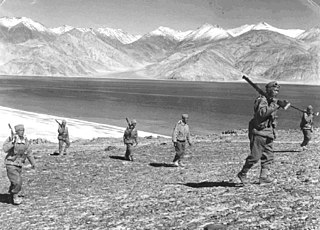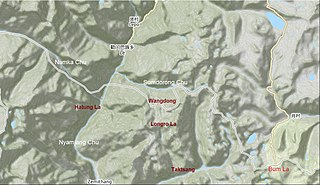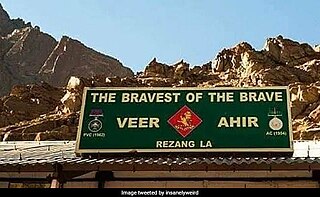
The Sino–Indian War, also known as the China–India War or the Indo–China War, was an armed conflict between China and India that took place from October to November 1962. It was a military escalation of the Sino–Indian border dispute. Fighting occurred along India's border with China, in India's North-East Frontier Agency east of Bhutan, and in Aksai Chin west of Nepal.

Aksai Chin is a region administered by China partly in Hotan County, Hotan Prefecture, Xinjiang and partly in Rutog County, Ngari Prefecture, Tibet and constituting the easternmost portion of the larger Kashmir region that has been the subject of a dispute between India and China since 1959. It is claimed by India as part of its Leh District, Ladakh Union Territory.

The Sikh Regiment is an infantry regiment of the Indian Army. It is the most highly decorated regiment of the Indian Army and in 1979, the 1st battalion was the Commonwealth's most decorated battalion, with 245 pre-independence and 82 post-independence gallantry awards, when it was transformed into the 4th battalion, Mechanised Infantry Regiment. The first battalion of the regiment was officially raised just before the partial annexation of the Sikh Empire on 1 August 1846, by the British East India Company. Currently, the Sikh Regimental Centre is located in Ramgarh Cantonment, Jharkhand. The Centre was earlier located in Meerut, Uttar Pradesh.

Subedar Joginder Singh Sahnan, PVC, was an Indian soldier and posthumous recipient of India's highest military award, the Param Vir Chakra. Singh joined the British Indian Army in 1936 and served in the 1st battalion of the Sikh Regiment. During the 1962 Sino-Indian War, he was commanding a platoon at the Bum La Pass in the North-East Frontier Agency. Though heavily outnumbered, he bravely led his troops against a Chinese assault and defended his post until he was wounded and captured. Singh died from his injuries while in Chinese custody. He single-handedly killed more than 50 Chinese soldiers, and became a war hero within the Indian Armed Forces.

The Rajput Regiment is one of the oldest infantry regiments of the Indian Army, originating in 1778 with the raising of the 24th Regiment of Bengal Native Infantry. The 1st battalion of the regiment was formed in 1798.

In 1986–87, a military standoff took place between India and China in the Sumdorong Chu Valley bordering the Tawang district, Arunachal Pradesh and Cona County, Tibet. It was initiated by China moving a company of troops to Wangdung, a pasture to the south of Sumdorong Chu that India believed to be its territory. The Indian troops stood their ground on the neighbouring Longro La ridge and both the sides moved a large number of troops to the border. The crisis was diffused after the visit of Indian External Affairs minister to Beijing in May 1987. The standoff gave rise to fears of escalation. Subsequently, India and China formulated agreements for managing future border tensions.
A long series of events triggered the Sino-Indian War in 1962. According to John W. Garver, Chinese perceptions about the Indian designs for Tibet, and the failure to demarcate a common border between China and India were important in China's decision to fight a war with India.

The Sino–Indian border dispute is an ongoing territorial dispute over the sovereignty of two relatively large, and several smaller, separated pieces of territory between China and India. The territorial disputes between the two countries result from the historical consequences of colonialism in Asia and the lack of clear historical boundary demarcations.

Nuranang Falls, 100 m high waterfall, is located 2 km northeast of the Jang town on the motorable Jang Falls Road in the Tawang district of Arunachal Pradesh state of India. Jang is 40 km southeast of Tawang, north of Sela Tunnel, and between Tawang and Bomdila on NH-13 Trans-Arunachal Highway. Jang Hydal Plant, near the base of fall, is a small hydel plant which generates electricity for local use.

The Bum La Pass is a border pass between China's Tsona County in Tibet and India's Tawang district in Arunachal Pradesh. It is 37 km away from the town of Tawang in India's Tawang district and 43 km from the town of Tsona Dzong in China's Tsona County. The pass currently serves as a trading point between Arunachal Pradesh and Tibet. It is also an agreed Border Personnel Meeting point for the security forces of China and India.
Sumdorong Chu is a tributary of the Nyamjang Chu river that flows along the disputed Sino-Indian border between the Tsona County of Tibet and the Tawang district of Arunachal Pradesh. It originates in the Tokpo Shiri Glacier, about 7–10 kilometres east of Nyamjang Chu, and flows down to the river. Its junction with Nyamjang Chu is to the north of that of Namka Chu, another contested river valley, by about two kilometers.

Namka Chu or Kejielang River is a tributary of Nyamjang Chu that flows along the disputed border between India and China. The Indian side of the border is the Tawang district in Arunachal Pradesh. The Tibetan side of the border is in Tsona Dzong, Shannan province of Tibet. Namka Chu originates near the trijunction of Tibet, Bhutan and India and flows east for 26 km before joining Nyamjang Chu. It is about 200 kilometers away from the Misamari railhead and 60 kilometers from the Tawang road head. The Namka Chu valley was the scene of some of the most fierce fighting between India and China during the 1962 Sino-Indian war.

Subedar Joginder Singh is a 2018 Indian Punjabi-language biographical war film based on the life of Joginder Singh, an Indian soldier who was killed in the 1962 Sino-Indian War and posthumously awarded the Param Vir Chakra. It is produced by Saga Music and is set to release by 6 April 2018. The film stars Gippy Grewal and Aditi Sharma and is directed by Simerjit Singh who belongs to the same region of Moga where Joginder Singh was born. This movie was a high budget film. The film is authentic to that in the era of 1962.

The Battle of Rezang La was a major military engagement that took place on 18 November 1962, during the Sino-Indian War between the Indian Army's 13th Kumaon Regiment and China's People's Liberation Army (PLA). 20 Indian soldiers of all-Ahir Charlie C Company faced more than 3000 Chinese soldiers and successfully defended the strategic mountain pass of Rezang La in Ladakh. Fought at an altitude of 16,000 feet, against overwhelming Chinese forces, the battle saw one of the greatest last stands, with Indian sources documenting more than 1400 Chinese casualties. Major Shaitan Singh, who led the defense, was posthumously awarded the Param Vir Chakra, India's highest military honor, for his extraordinary bravery. Several other decorations were awarded posthumously to many officers and soldiers of the company.
Dhola Post was a border post set up by the Indian Army in June 1962, at a location called Che Dong, in the Namka Chu river valley area disputed by China and India. The area is now generally accepted to be north of the McMahon Line as drawn on the treaty map of 1914, but it was to the south of the Thagla Ridge, where India held the McMahon Line to lie. On 20 September 1962, amidst various border tensions, the post was attacked by Chinese forces from the Thagla Ridge, and sporadic fighting continued till 20 October when an all-out attack was launched by China leading to the Sino-Indian War. Facing an overwhelming force, the Indian Army evacuated the Dhola Post as well as the entire area of Tawang, retreating to Sela and Bomdila. After the war, the post was left unoccupied until the 1986 Sumdorong Chu standoff, after which the area was again strengthened by the Indian Army.
Nyamjang Chu, or Nyashang Chu (Tibetan: ཉ་བཤང་ཆུ, Wylie: nya bshang chu, THL: nya shang chu) is a cross-border perennial river that originates in the Shannan Prefecture of Tibet and flows into the Arunachal Pradesh state of India, joining the Tawang Chu river just before it enters Bhutan. The Nyamjang Chu valley has provided the traditional communication route between Tawang and Tibet. The valley near town of Zemithang in the Tawang district, called the Pangchen Valley, is known for its serene beauty and forms one of the wintering locations for the black-necked crane.
The Battle of Namka Chu took place during the Sino-Indian War. After multiple border skirmishes, Chinese forces invaded Namka Chu, and won a victory. Namka Chu is a river that is along a major border dispute of China and India at the time.

The Battle of Walong took place during the Sino-Indian War of 1962. It took place near the town of Walong in the eastern sector of the conflict, in the present-day Arunachal Pradesh region of India. Indian forces, despite being outnumbered and under equipped, resisted the Chinese advance for nearly a month.

Tsogtsalu or Tsolu is a pasture and campsite in the Ladakh union territory of India, in the Chang Chenmo Valley close India's border with China. It is located at the confluence of the Rimdi Chu river that flows down from Marsemik La and the Chang Chenmo River. During the British Raj, this was a halting spot for travellers to Central Asia via the 'Chang Chenmo route', passing through Aksai Chin. After Indian independence, a border outpost was established here by a border police party headed by Captain Karam Singh. It continues to serve as a base for India's border forces.
Tulung La (Tibetan: ཐུ་ལུང་ལ་, Wylie: thu lung la) is a border pass between the Tsona County in the Tibet region of China and India's Tawang district in Arunachal Pradesh. It is in the eastern part of the two districts, close to the Gori Chen cluster of mountains, on a watershed between the Tsona Chu river in Tibet and the Tawang Chu in the Tawang district. The watershed ridge forms the border between Tibet and India as per the McMahon Line. Tulung La provided an invasion route to China during the 1962 Sino-Indian War. It is also the scene of occasional clashes between the two sides.












